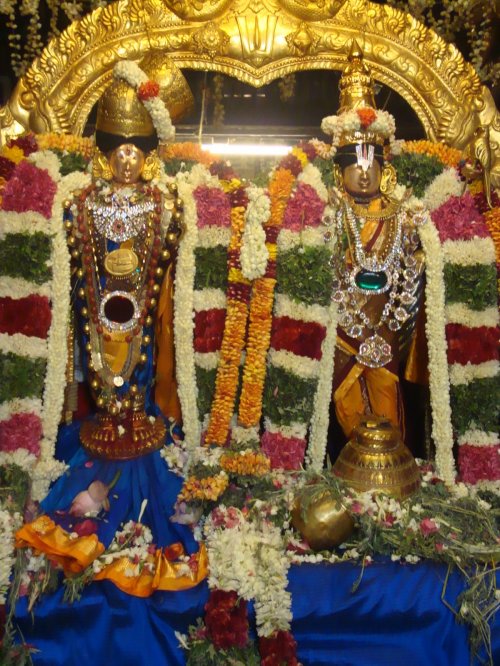Published from “Three Minutes” series written by A.S.Rajagopalan Swami of Ohio.
 ANDAL, revered as the manifestation of earth goddess (bhUdevi), has two magnificent compositions: (1) tiruppAvai, which squeezes out the essence of scriptures (veda-s) in only thirty stanzas and (2) nAcciyAr tirumozhi, a one hundred and forty three verse stotram that pours out the outcry of a wretched maiden longing for her lover, Lord KR^iShNa.
ANDAL, revered as the manifestation of earth goddess (bhUdevi), has two magnificent compositions: (1) tiruppAvai, which squeezes out the essence of scriptures (veda-s) in only thirty stanzas and (2) nAcciyAr tirumozhi, a one hundred and forty three verse stotram that pours out the outcry of a wretched maiden longing for her lover, Lord KR^iShNa.
In this famous decad (pattu) of ten verses (pAsuram-s), commonly referred as “vAraNam Ayiram”, a section of her nAcciyAr tirumozhi, shrImAti ANDAL, gOda pirATTi describes Her dream wedding (vivAha) with shrIman nArAyaNa according to the scriptures (vedic tradition).
It is still customary to sing these ten verses during the weddings of shrIvaiShNava-s. Let us first understand why they sing these verses. Traditionally (sampradAyam), the son-in-law is deemed to be equal to that of Lord MahAviShNu, the supreme deity, at least on the wedding day. jAmAtA viShNuvat pUjyaH or jAmAtA paramo devatA is the saying. The bride is thought of as gOda pirATTi. Thus, everyone visualizes a symbolic wedding between Lord nArAyaNa and gOda pirATTi and not just between a boy and girl. Thus, the recitation of vAraNam Ayiram captures that ideal. During the “tying the knot ceremony” (mAngalya dhAraNam), the bride will be dressed up in ANDAL’s attire with a side-pointing cone (konDai) hairstyle.
There is a saying “Any food that is not presented to Lord Govinda and any wedding without vAraNam Ayiram is worthless”. The main idea here is to think of the Lord and thank Him before eating any food. Similarly, in the wedding, one has to follow the ritualistic steps explained in this decad during the wedding process, in addition to just reciting these verses.
Everyone is familiar with a wedding in some way. It would be interesting to know the details of different steps and the reason behind them. The intricate meanings (svApadesam) of these ten verses parallel the scriptures (veda-s) and can be understood through traditional explanatory texts (vyAkhyAnam). Let us look at a brief view of these ritualistic steps and look into the current day wedding in order to introduce some familiarity with the tradition.
The ten steps described here are the major portion of any Indian wedding.
1. Reception of the bride groom (mApiLLai azhaippu, jAnavAsam)
2. Announcement of wedding ceremony (niscayatArtham)
3. Elders’ consent and Sister-in-law (nAttanAr kodi uduttal) to dressup the bride
4. Tying the holy string on hand (kAppu kaTTal or rakShA bandan)
5. Removing the obstacles (piDisuRRudal)
6. Holding the hands together (pAnigrahaNam)
7. Walking seven steps together, wedding vows (agni pradakShiNa, saptapati)
8. Stepping on the stone (shilArohaNam, ammi midittal)
9. Offering of puffed rice (lAja hOmam, pori iDudal)
10. Sprinkling yellow holy water (manjaL nIr teLittal)
Finally, ANDAL concludes with a summary stanza where she identifies Herself as periyAzhvAr’s daughter and highlights the benefits of reciting these ten stanzas.
Today’s shrIvaiShNava wedding may vary from these to suit to social customs, family tradition, local beliefs, elders’ wishes etc. For example, sequences like married women’ prayers (sumangali prAthanai), tying the knot (tirumAngalya dhAraNam), pilgrimage to kAsi (kAsi yAtrA), swaying the swing (Unjal), welcoming the bride to new home (GR^ihapravesham) dissolving grains (pAligAi karaittal) are invariably included in many weddings, though not highlighted explicitly in ANDAL’s verses.
One may wonder, why ANDAL did not mention the most important step of tying the knot (tirumAngalya dhAraNam)? It may be left out because that step does not involve any recitation of scripture (vedic mantras), but rather, it is just uttering a prayer verse (shloka) only.
We will look into some details each step from AndAL’s perspective for the next few days.
 I have spread my dreams beneath your feet; Tread softly because you tread on my dreams
I have spread my dreams beneath your feet; Tread softly because you tread on my dreams









Great write up. Very Apt.For the bridegroom is indeed treated as Vishnu, and therefore, Varanamayiram , marriage with Godha Piratti is the essential step,as we celebrate the Lord’s marriage with Thayar
Really enjoyed reading this. Thank you!